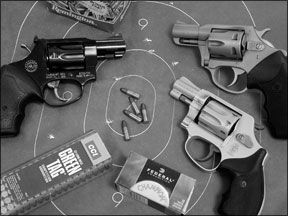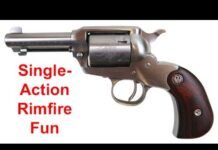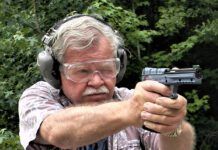As the cost of centerfire ammunition continues to ascend, many gun owners will turn to the standby 22 LR round as a way to shoot economically, whether those pursuits include knocking over cans, punching holes in paper, or killing the occasional rodent. Of the many available guns chambered for the rimfire round, perhaps the easiest to load and shoot and enjoy is the revolver.

We recently tested a trio of wheelguns chambered for the 22 round, and versions of two of them have previously been tested and graded for their utility. For example, just over a year ago (October 2007), we shot the Taurus Model 94SS4, $406. That stainless-steel gun with a 4-inch barrel got a B-, mainly because it was too heavy to be considered as a trail gun. We also said back then, “But the Taurus is a great deal less costly, so if you dont mind its weight and if you can do without extreme accuracy, it might be right for you. It looked great, performed quite well, and was easier to load and unload.”
We were more enthusiastic about a Taurus Model 94B2UL Ultra-Lite Nine, $375, reviewed in March 2006. We said of that gun, rated a Best Buy: “…All in all, the Taurus doesnt need a lot to make it into one of the finest 22 revolvers weve seen. As we found it, it worked well, and the price was modest.”
In that same issue, there were two Smith & Wessons reviewed. The 4-inch S&W Model 317-2 HIVIZ No. 160221, $691, earned a Conditional Buy because “…We liked this gun in every respect but for its trick sights. Wed throw them as far as we could, as fast as we could, if we owned this gun, and put on a black or red front post and a square-notch rear as fast as you can say HIVIZ.” Next, the S&W Model 317-2 Air Lite No. 160222, $633, received a Dont Buy rating, with our staff saying, “There was nothing whatsoever wrong with this gun, and some readers might have a desperate need for it, and theyll buy it no matter what we say. …We would not buy this gun as long as its adjustable-sighted brother [the HIVIZ unit] was available, unless we had a great need for the smallest, lightest 22 revolver for some special close-range purpose.”
With that background in mind, we acquired a 22 revolver we havent tested, a Charter Arms Pathfinder No. 72224, a 2-inch-barrel stainless gun that MSRPs for $350. The 6-shooter weighs in at 21 ounces, more than the lightweight aluminum-alloy-frame Smiths and about the same as the Tauruses weve tested. The Pathfinder comes with a Patridge front sight, square-notch rear sight, and full rubber grips.
Since we had previous reviews of what are the equivalent of guns rated D or F, (the Dont Buy-rated S&W Model 317-2 Air Lite No. 160222) and what would be an A- or A gun (the Best Buy-rated Taurus Model 94B2UL Ultra-Lite Nine), we went to Fountain Firearms in Houston (fountainfirearms.com) and got fresh samples of those two and pitted them against the Charter, bracketing it. Would the Charter hold its own against the top-ranked Taurus? Would the Pathfinder navigate our tough testing protocol and again leave the Air Lite in the cellar? Extensive shooting would establish the Charters proper place in the established Gun Tests hierarchy, or so we thought.
How We Tested
We took our test guns to American Shooting Centers in Houston along with an Oehler 35P chronograph, plenty of Caldwell Orange Peel 8-inch Bullseye Targets, and several thousand rounds of 22 ammo from four companies. Our test rounds included Remington Golden Bullet 36-gr. roundnose hollowpoints, CCI Green Tag 40-gr. solid-lead roundnoses, Federal Champion #510 40-gr. solid-lead roundnose bullets, Remington Thunderbolt 40-grain lead roundnose No. TB-22A ammo, and Wolf Match Extra 40-grain lead roundnose fodder.
Our test team included two men and two women, and at the urging of the women, we shot both accuracy and timed sessions, the latter into a silhouette target. Reason: The women argued that these pistols are legitimate self-defense guns for some people-notably other women-who dont want to carry a centerfire gun. They pointed out that any gun, even a rimfire, is better than no gun, and that as self-defense choices, rimfires were much easier to train with and carry, and they were more affordable. This lead to an interesting set of evaluation points that considered weight and capacity as important factors.
Both the bullseye session and the silhouette portion were shot at 10 yards. During the accuracy session we fired five-shot groups from a sandbag rest set on a wooden shooting bench. The Orange Peel targets showed bullet impacts instantly, so we had immediate feedback from our shot call to hit location. Our accuracy testing took place on a bright, cloudless 80-degree day with variable winds coming mostly from 4 to 6 oclock.
On a separate day, the timed session had shooters at the line with guns at low ready, resting on top of the pistol bench-about a 55-degree downward angle. At a verbal command of “Go” from a timer directly behind the shooter, the shooter would raise the handgun and fire two shots into the center of a Law Enforcement Targets B-27S qualification silo target and two rounds into the silhouettes head. The monitor recorded the times with a stopwatch, and we rejected any shot fired after 2.5 seconds.
Each shooter fired five strings of four shots, or 20 shots, for a total of 80 rounds per gun. We counted any hit in the 8, 9, or 10 rings as a good shot in the silhouettes body, and any hit in the head as a good shot. We learned that this sequence highlighted flaws in the trigger and sights that we didnt see in the accuracy portion. Details on that and other points follow below on a gun-by-gun basis.
Charter Arms Pathfinder
No. 72224 22 LR, $350
Charter is based in Shelton, Connecticut. The companys main lines are the 38 Special Undercover and Off Duty products, a quartet of 357 Magnum Mag Pugs, and five 44 Special Bulldogs. It also builds a 32 H&R Magnum Undercoverette, a couple of 327 Federal Magnum Patriots, and two Dixie Derringers. In the rimfire line, there are four Pathfinders, 2- and 4-inch 22 Long Rifles and 2- and 4-inch 22 Magnums, all stainless steel. We tested the 2-inch 22 LR gun here.
Charter guns have one-piece frames, eight-groove rifling in the barrels, shrouded ejector rods, a hammer-block transfer-bar safety system, wide trigger and hammer spur, and cylinder lock-up in three places. The barrel is threaded into the frame, and the smooth stainless front sight is part of the barrel. Theres no cylinder stop. Charter claims the eight-groove rifling produces better accuracy and more velocity, but we didnt see that in our testing. The ejector rod was protected in a lug, unlike the rods on the other two guns.
Our test gun measured 6.5 inches long, 4.9 inches tall, and 1.3 inches thick across the six-shot steel cylinder. The sight radius was 4.0 inches in length. The rubber grip was longer than on the other two guns, and the backstrap was covered, unlike on the S&W gun. The grip measured 1.1 inches in thickness and was 5.0 inches around at the base of the grip.
There was a lot to like about the Pathfinder. As noted above, the checkered rubber grip with finger grooves gave a comfortable, controllable grip surface that allowed three fingers to pull on the frontstrap. The other two guns didnt have a place for the pinkie to ride. The guns single-action trigger pull was crisp and not too heavy at 6.2 pounds, and the 16.5-pound DA pull weight was at least a pound and a half less than the others. This became an issue for the female shooters, one of whom had trouble making the Taurus and Smith guns work double action.
The Charters hammer measured .300 inch wide, with the Taurus hammer going .355 inch and the Smiths .245 inch. Both the Charter and Taurus were much easier to cock using the hammer, we thought.
Our first impression at the range was worry, because we could not see the front sight very well. When we aligned the top of the front sight with the horizontal yellow line in the middle of the Orange Peel target, we noticed the top of the hammer spur obscured half of the front sight. Then, as the hammer rode back, the front of the hammer near the striking surface rotated up into the sight picture, which was distracting. Moreover, holding sights level in the middle of the bullseye put shots more than 6 inches low at 10 yards. Instead, we had to hold at the top of the target, or align the base of the front sight in the notch, to get the gun to shoot near where we wanted the bullets to go. We would much rather it shoot high from the factory, because a 6 oclock hold doesnt obscure the target. During the timed portion of the test, this sighting issue was only half of a problem. For body shots in the middle of the silo target, we simply moved to and held at the top of the main target mass, and all the shots fell into the 8-ring or better. Head shots, however, were difficult because the sight and barrel obscured the target, because we knew the gun shot low. We put only 50% of the head shots on the target, both as misses and because some shots were fired beyound the 2.5-second window.
Light bars inside the rear sight were okay. The front blade measured .150 inch and the rear notch .185 inch, so we didnt have a problem with horizontal alignment.
At the bench, five shots fell into 2.3-, 1.8-, and 2.0-inch average groups respectively with the Remington, CCI, and Federal rounds. Both the Smith (1.5 inches) and the Taurus (1.4 inches) shot much better with the Golden Bullet. The Charter outdueled the Smith (2.6 inches) with the CCIs, but lagged behind the Ultra-Lite (1.6 inches). With the Federal Champions, both the Air Lite (1.7 inches) and the Ultra-Lite beat the Pathfinder. In fact, the Taurus guns groups with the Federal ammo averaged 1.0 inches, the best average group size in the test. (To no avail for the Bulls gun, as we relate later.)
But there were downsides, too. Charter claims its “3-point cylinder lock-up” is an exclusive feature, but we didnt see how it was better than the lockup on the 317 or 94. All three guns used a central sprung pin main lockup at the rear of the cylinder, with the Charters pin also catching a cutout in the crane when the rod snaps rearward. At that point, the Taurus added a sprung latch pin in the crane that snapped into a cut in the top of the frame. The Smith used a spring-loaded pin at the front of the ejector rod as its second contact point. Our inspection showed the Charter to have a minor amount of front-end shake, while the Smith and Taurus didnt.
Fit was an issue as well, with the crane showing larger joints than on the Smith and Taurus guns, we thought. Where the barrel met the frame wasnt blended well, in our opinion, with differently shaped pieces butting together. The barrel was .674 inch wide, and it gave the gun a noticeable muzzle-heaviness that the .616-inch-diameter Taurus steel barrel didnt have, and certainly the aluminum-shrouded .530-inch-diameter Smith barrel was more nimble, in our view.
On portability, the Charter fell behind the 317, weighing in at 21 ounces, 2 ounces heavier than the companys specs and an ounce heavier than the Taurus. The Smith was half that at 10.5 ounces.
Another downside was that the Charters ejector rod was sticky when spent rounds were in the cylinder. We sometimes had to break the cases out by pushing the ejector-rod tip against the bench, then ejecting the cases. The other two guns dumped cases easily and smoothly with a push on their knurled ejector-rod tips. Also, the Charter only carried six rounds, while the Smith had eight and the Taurus nine. If you plan on carrying a 22, which we dont advocate, having the extra two or three shots would be a big advantage, in our opinion.
Taurus 94B2UL Ultra-Lite
Nine 22 LR, $370
This Taurus had a nicely blued finish, adjustable white-outline square-notch rear sight, a red insert in the flat-top front post, and nice rubber grips. The front sight was easy to see, with the blade measuring .095 inch thick and the rear notch .105 inch. Adjusting the rear sight for elevation and windage was easy with a small flat-tip screwdriver.
The Taurus measured 6.5 inches in length, stood 4.4 inches tall (because of its shorter grip), and 1.4 inches thick across the nine-shot steel cylinder. Its rubber grip covered the backstrap, same as the Charter. The grip measured 1.1 inches in thickness and was 4.6 inches around at the base of the grip. Its overall size and weight were essentially identical to the Charter, but a good deal heavier than the Smith. The frame of the Taurus was aluminum alloy. The cylinder, barrel, crane, sights, hammer and trigger were steel.
The SA pull was 5.75 pounds; the DA pull was about 18 pounds, slightly better than the S&Ws DA pull but not quite as good as the Charters. Fit and finish were excellent, with tight joints all around.
At 10 yards, the Taurus easily shot the best overall, recording the smallest groups with every ammo we tested. So, at this point, you might assume we had a winner with the Taurus. Just one problem: It didnt work. In our initial function testing, we would shoot a round, and the cylinder would bind. We would have to open the cylinder, spin it, and snap it back into place, and then continue shooting. Sometimes we would make it through all nine shots, sometimes not. We thought it might be a case rim-thickness problem that was causing the cylinder to bind, so we added other ammo brands, but it malfunctioned with every one we tried.
All the elements for a good gun are here, if the gun you buy happens to work. Caveat emptor.
S&W Model 317-2 Air Lite No. 160222, $535
Nothing of note has changed on this gun over the last two years. It holds eight shots, includes short black-rubber Uncle Mikes Boot Grips, and has very little steel, making it light. It uses a bobbed hammer that allows the shooter to cock it for single-action shooting, and Smiths smooth Clear Coat finish covers the exterior.
Smith achieves some of the weight savings by cutting deep cylinder flutes, shaving channels into the rear strap and bottom of the trigger guard, and using a stainless steel barrel liner inside an alloy barrel shroud. The cylinder, frame, crane, and barrel shroud were aluminum alloy. The closed gun was gun was tight, due to lockup where the ejector rod fits into the barrel lug at its extreme forward tip and via a central locking pin at the back of the cylinder.
The sights were a serrated, sloped-ramp front post and a square notch cut into the top rear of the frame. These sights gave a good sight picture as long as they were strongly lit from above. In dim light, it was hard to separate them. And, of course, they werent adjustable, like the Tauruss were.
As previously noted, the DA pull was too heavy. Some women, who might be the prime customers for this gun as a purse-or-pant carry of last resort, may not be able to squeeze a round off with one hand. For them, this gun would have to be resprung.
As we reported in the Charter section, this gun shot good grips with Remington and Federal ammo, coming in second to the Taurus both times. The center of impact was slightly high, and theres no easy way to fix that because the sight blade was integral with the barrel shroud. In rapid-fire double-action shooting, the shooters who could work the DA trigger scored 100% hits in the silhouette body and 75% hits in the head area of the target. The misses were high because the front sight was hard to see when it was level, and we unconsciously tended to raise the muzzle to see more of the top of the gun. Our testers also noticed that the trigger tended to pinch the trigger finger pad at the back of the guard when they shot the gun double action.
1108-RIMFIRE-HANDGUNS-ACCURACY.pdf
1108-Charter-Arms-Pathfinder.pdf



























